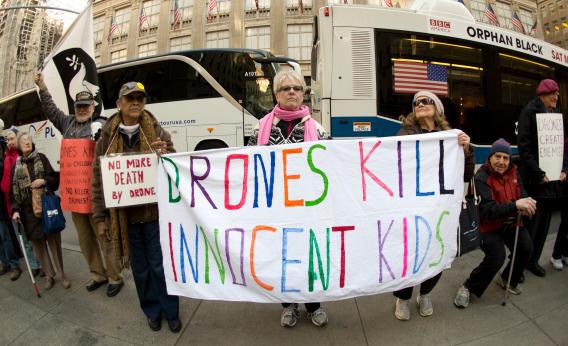“A Secret Deal on Drones, Sealed in Blood,” says the front page of Sunday’s New York Times. The story’s opening paragraphs portray the drone war in Pakistan as the product of deceit, murder for hire, and a willingness to kill civilians. But the article, adapted from Mark Mazzetti’s new book, The Way of the Knife, tells a more complicated story. The drone war isn’t as clean as its masters pretended. Nor is it as dirty as its critics often imply.
Mazzetti’s reporting, based on “interviews with more than a dozen officials in Pakistan and the United States,” reveals ugly truths about the drone campaign. Here’s a summary:
1. To get permission to hunt our enemies in Pakistan, we killed an enemy of Pakistan first. Mazzetti features the story of Nek Muhammad, a tribesman in the frontier provinces who in 2004 became the first Pakistani target killed by Predator drones. U.S. officials “considered him to be more Pakistan’s problem than America’s,” Mazzetti writes. Nevertheless, the CIA “agreed to kill him in exchange for access to airspace it had long sought so it could use drones to hunt down its own enemies.”
2. The CIA switched from interrogations to drone strikes because killing was safer and easier. Mazzetti says a report by the CIA’s inspector general, completed in May 2004, “was perhaps the single most important reason for the CIA’s shift from capturing to killing terrorism suspects.” The report detailed abuses of detainees in the agency’s post-9/11 interrogation program. “Killing by remote control was the antithesis of the dirty, intimate work of interrogation,” Mazzetti writes. “Targeted killings were cheered by Republicans and Democrats alike, and using drones flown by pilots who were stationed thousands of miles away made the whole strategy seem risk-free.”
3. The U.S. and Pakistan agreed to conceal or misrepresent who did the killing. According to Mazzetti, in the 2004 deal to permit Predator strikes, the CIA and Pakistan’s intelligence agency agreed that the U.S. “would never acknowledge the missile strikes and that Pakistan would either take credit for the individual killings or remain silent.” After Muhammad’s death, a Pakistani military spokesman falsely told reporters that a Pakistani rocket attack had killed Muhammad and that the U.S. had played no role.
4. The concealment and misrepresentation included who was killed. Contrary to Pakistan’s statements, Mazzetti reports, Muhammad “was not a top operative of al-Qaida.” And while Pakistan claimed that the attack on him had killed four other “militants,” the death toll actually included “two boys, ages 10 and 16.”
5. The deal protected other terrorists. According to Mazzetti, “Pakistani intelligence officials … insisted that drones fly only in narrow parts of the tribal areas—ensuring that they would not venture where Islamabad did not want the Americans going: Pakistan’s nuclear facilities, and the mountain camps where Kashmiri militants were trained for attacks in India.” This detail, tucked away in the story’s 26th paragraph, is in some ways the most damning revelation. It undercuts the anti-terrorist rationale behind the deal.
Do these disclosures discredit the drone war? I don’t think so. To answer that question, you have to look more deeply at the context.
It may be true that the exposure of post-9/11 interrogation abuses in 2003 and 2004 pushed the CIA away from detention and toward targeted killing. But that process was already underway. Toward the end of the story, in the 40th paragraph or so, you’ll learn that the CIA’s internal debate over the morality and legality of armed drones actually peaked in 2001. What settled that debate was 9/11. We decided to kill the people who had killed us by the thousands.
Second, Muhammad may not have been a top al-Qaida operative, but Pakistan’s description of him at the time of his death—an “al-Qaida facilitator”—seems to be true. Mazzetti reports that after the U.S. invasion of Afghanistan,
“[Muhammad] seized an opportunity to host the Arab and Chechen fighters from al-Qaida who crossed into Pakistan to escape the American bombing. For Mr. Muhammad, it was partly a way to make money, but he also saw another use for the arriving fighters. With their help, over the next two years he launched a string of attacks on Pakistani military installations and on American firebases in Afghanistan.”
In short, Muhammad wasn’t just Pakistan’s enemy. He was ours, too. He was targeting our people. So we weren’t just offering to do Pakistan’s dirty work. We were picking the guy on our list whose death was most likely to whet the appetite of our would-be collaborators.
Third, the drone strikes, for all their ugliness, were better than what they replaced. Mazzetti reports that prior to the June 2004 strike on Muhammad, Pakistani President Pervez Musharraf
“ordered his troops into the forbidding mountains to deliver rough justice to Mr. Muhammad and his fighters, hoping the operation might put a stop to the attacks on Pakistani soil … In March 2004, Pakistani helicopter gunships and artillery pounded Wana and its surrounding villages. Government troops shelled pickup trucks that were carrying civilians away from the fighting and destroyed the compounds of tribesmen suspected of harboring foreign fighters.”
A subsequent cease-fire soon collapsed. Muhammad “resumed attacks against Pakistani troops, and Mr. Musharraf ordered his army back on the offensive in South Waziristan.” This is what the U.S. strike on Muhammad shattered: not peace, but a bloody ground war full of civilian casualties.
These caveats don’t make the drone war honest, brave, or clean. But they do challenge us to be as careful in criticizing it as we expect the government to be in conducting and justifying it. The rise of the Predators over Pakistan wasn’t innocent. Neither were the terrorists who provoked it, the ground wars that preceded it, or the blood that sealed the deal.
William Saletan’s latest short takes on the news, via Twitter:
